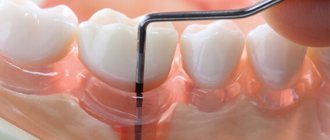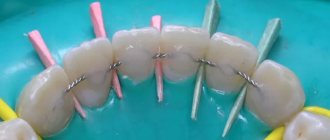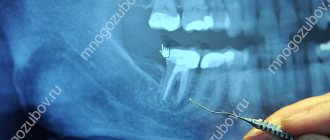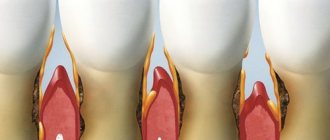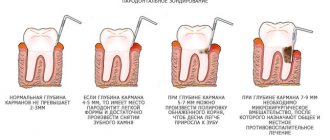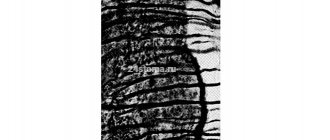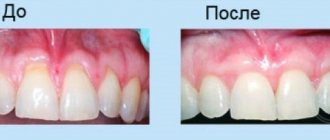After reading this article, you will learn about:
- the essence of periodontitis and the features of its treatment;
- reasons that determine the need for surgical treatment of periodontitis;
- available methods of surgical control of this disease;
- pros and cons of existing methods;
- patients’ opinions about each of the presented techniques;
- the best ways to treat periodontitis.
Before you begin to study the available methods of surgical treatment of periodontitis, it is necessary to become familiar with the causes of this disease.
Make an appointment with a therapist by phone+7(985)532-21-01
Causes of periodontitis and its consequences
Many people are too negligent about oral hygiene. This leads to the fact that plaque and hard deposits begin to form on the teeth, indicating the appearance of the first signs of periodontitis. These processes are accompanied by bleeding and inflammation of the gums. The primary signs of the development of periodontitis also include tooth mobility and the appearance of purulent discharge from under the gums.
Subsequently, the soft plaque on the teeth mineralizes and becomes tartar, which promotes the release of toxins. These, in turn, cause gum inflammation and other adverse consequences.
Such consequences, first of all, include the gradual resorption of bone tissue around the tooth. In its place, granulation tissue appears, which contains many microbes that absorb the bone. This process contributes to a significant acceleration of bone tissue atrophy.
Another unpleasant consequence is the formation of periodontal pockets. They represent an area with destroyed bone tissue and a cavity that is filled with granular tissue, pus and dental plaque. To detect this pathology, x-rays or probing are required. It is worth adding that the periodontal pocket is often called the dental or gingival pocket.
Identification of a deep periodontal pocket (from 3 mm) means that the patient will no longer be helped by drug therapy. This is due to the fact that the destruction process has already taken an irreversible form.
The ineffectiveness of drug and therapeutic treatments can be explained by several reasons:
- Even the most qualified doctor cannot guarantee the removal of all subgingival deposits by inserting an ultrasonic tip under the gum. The lack of confidence in the 100% result of therapy is due to the fact that no specialist will be able to control what is happening in the periodontal pockets. That is why a large amount of destructive sediment remains there.
- This procedure is considered quite labor-intensive and expensive. However, it does not guarantee complete elimination of the problem.
- If the specialist manages to completely remove all subgingival deposits from the pocket, favorable conditions for the development of periodontitis will still remain in the oral cavity. Therefore, even removing all deposits will not stop the progression of the infection.
In such situations, the only effective treatment option is surgery. Only in this case will the removal of all subgingival deposits, granulation tissue and periodontal pockets be ensured.
Surgical methods for treating periodontitis
There are 3 main methods of surgical treatment of this disease:
- open curettage;
- closed curettage;
- flap surgery.
The main purpose of curettage
The goal when performing this dental procedure is the same - the removal of pathological formations in the periodontal pocket: tartar and granular bacterial deposits. Hence the name: from the French word “curettage” - scraping.
Indications
Indisputable reasons for performing the procedure:
- inflammatory process, especially in chronic form;
- tartar, which causes displacement of soft tissues;
- deep periodontal pockets (over 4mm);
- tooth mobility.
Contraindications
Curettage, being a rather complex operation, is contraindicated for:
- thinning gums or fibrous tissue changes;
- infectious diseases of the oral cavity;
- excessive bleeding gums;
- the depth of the pockets is more than 6 mm or the presence of pus in them;
- bite pathologies;
- individual intolerance to anesthesia.
Closed curettage of periodontal pockets
Closed curettage is performed to eliminate subgingival dental plaque and granulation in the gingival pockets. The main disadvantage of this method is the fact that when performing closed curettage there is no view of the gingival pockets and root surface. Therefore, this procedure does not guarantee the removal of all deposits and granulations.
Closed curettage will be effective if the depth of the patient’s gum pockets is no more than 3 mm. This means that the patient has mild periodontitis. If the patient is diagnosed with a more complex stage of this disease, closed curettage will provide only short-term relief. In addition, it will not be able to stop the progression of periodontitis.
Such operations are usually performed in regular dental clinics, which do not have qualified periodontal surgeons on staff.
It’s worth making a small note here. Periodontists are dentists who typically treat periodontitis and its consequences. In particular, periodontists specialize in the treatment of gingivitis. Despite the fact that this disease is considered less dangerous, it can also cause serious problems for the patient. Gingivitis is characterized by swelling, bleeding and discoloration of the gums. In addition, this disease contributes to the appearance of unpleasant odor from the mouth, as well as burning, itching and other unpleasant sensations in the gums.
The effectiveness of treatment of both periodontitis and gingivitis depends on the timely diagnosis of these diseases. To diagnose these pathologies, periodontists conduct a visual examination using special techniques that allow them to identify signs of the development of these diseases and provide timely qualified assistance.
Early stage gingivitis involves procedures such as removing plaque, smoothing the surface of the tooth root, and cleaning out stones in periodontal pockets. If the patient has a middle or late stage of gingivitis, then in this case surgical intervention cannot be avoided.
To summarize , it is worth saying that the work of a periodontist is not only the treatment of periodontal diseases. Depending on the patient’s goals, this specialist also carries out a preventive examination, allowing him to make recommendations that will help prevent the occurrence of various diseases in the oral cavity.
Some patients may need a complete diagnosis of the oral cavity, which will determine the causes of periodontitis and other diseases, as well as develop recommendations and the most effective methods of therapy.
In general, any qualified dental clinic needs a specialist such as a periodontist. Patients with periodontal disease should contact this specialist.
Laser curettage
A laser beam as a method of removing dental plaque has a number of advantages:
- No bleeding
- Instant evaporation of granulation tissue
- Destruction of pathogenic microflora
- Fast recovery
The surgical field remains sterile throughout the operation, which takes from 15 seconds to 2 minutes per tooth. The minimally invasive method speeds up healing by 5 times. The disadvantage of this method is the need to repeat procedures. In mild cases, 2 are enough, in severe cases, you have to do 6-8.
Open curettage of periodontal pockets
Open curettage is carried out to restore bone tissue, as well as eliminate subgingival dental plaque and granulation in the gum pockets by replanting synthetic tissue. This operation is performed under local anesthesia. Carrying out this operation requires serious preparation: removing dental plaque, anti-inflammatory therapy, etc. It is worth adding that during such a surgical intervention, a segment of 7-8 teeth is usually operated on.
How is open curettage performed?
The first step of the specialist is to make an incision around the dental necks that require treatment. The incision allows flaps of gum lining to peel away from the teeth. Due to this, the surgeon sees the surface of the tooth roots and bone defects. Thus, the specialist will be able to visually identify all existing subgingival deposits and periodontal pockets.
The surgeon uses ultrasound to remove tartar and granulation. After this, the roots of the teeth and bone tissue are treated with an antiseptic. This action is necessary before you begin planting synthetic fabric. It should be noted that this procedure does not guarantee complete tissue restoration, but it can significantly reduce the width and depth of dental pockets.
Synthetic bone tissue deserves special attention. It is an artificial raw material in powder form. The main advantage of this material is its hypoallergenicity.
After replanting the synthetic tissue, the periodontist begins to place sutures in the area of the interdental papillae. After this, a bandage is applied to the operated area. The stitches must be removed after 10 days.
How to avoid complications after open curettage of periodontal pockets
Having gained access directly to the source of inflammation, which is only possible during open curettage, the doctor removes both the contents and the periodontal pocket itself. More precisely, as a result of thorough cleaning and grinding of the root surfaces, all factors that can cause its reappearance are eliminated, and the installed osteotropic material promotes targeted regeneration of bone tissue, which over time will fill the resulting voids and will reliably hold the tooth, depriving it of mobility. However, the result of a brilliantly performed operation (open curettage is a difficult operation and is performed exclusively by highly qualified, experienced surgeons) may suffer from the patient’s improper behavior in the postoperative period.
What should not be done after open curettage of periodontal pockets for 2–3 days:
- brush your teeth with a brush, brush, floss and irrigator in the surgical area.
- eat too hard and hot food.
- take poses in which blood rushes to the head.
- visit baths and saunas
- exercise
- smoke and drink alcohol.
Painful sensations characteristic of the first three days after surgery are relieved by taking sedatives and painkillers. For speedy healing, the wound should be treated with an antiseptic. It is recommended to sleep with several pillows under your head (in a semi-sitting position). Special (for sensitive teeth) toothpastes (or gels) will help to cope with increased sensitivity of teeth, which is possible after surgery. After about a month, you need to see a surgeon who will assess the condition of the periodontal tissues and, if the result is unsatisfactory, prescribe a repeat operation (this happens rarely and is mainly due to the patient’s unawareness of the full complexity of the surgical intervention).
Flap surgery on gums
Flap surgery on the gums in dentistry allows you to:
- remove granulations from under the gums;
- clean out subgingival deposits;
- eliminate periodontal pockets;
- stimulate the restoration of bone tissue by adding a synthetic analogue.
It is worth noting that all of the listed goals of periodontal flap surgery completely coincide with the goals of open curettage.
But still, there is one significant difference between these methods. It lies in the fact that patchwork surgery on the gum involves making an incision 1-1.5 mm from the edge of the gum. This strip of gum is completely cut out due to the fact that it loses its ability to adhere tightly to the surface of the teeth. The last stage of this operation is the tension of the flaps of the gum mucosa to the dental necks. Due to this, the periodontist prevents the possibility of “recession” of the gums.
Flap operations can be relevant both in the presence of generalized periodontitis and in cases where the surgeon is faced with the task of preventing receding gums and exposing the roots.
In order to become more familiar with the advantages and disadvantages of the presented methods, it is necessary to carefully study the reviews of patients who have experience in performing the listed operations.
Curettage in dentistry
It is important to see the difference between professional hygiene and curettage. In the first case, the teeth are thoroughly cleaned, deposits are removed, polished, and a paste with a high fluoride content is applied. In the second case, in addition to deposits, tissues that have undergone pathological transformation and are involved in the formation of the bottom and wall of the periodontal pocket (for example, softened dental cement, areas of granulation, etc.), as well as microorganisms, the consequences of their active reproduction, and tissue decomposition products are removed.
The advantage of closed curettage
This procedure is quite quick and painless. The main advantage of closed curettage is the fact that even a regular dentist can perform it. Another advantage of this procedure is its low cost. Unfortunately, closed curettage has no other advantages. At the same time, it has many more shortcomings.
First of all, this operation can only be effective at a mild stage of periodontitis. If deep dental pockets are detected, closed curettage will be inappropriate. Another disadvantage is that this technique does not guarantee the prevention of the progression of periodontitis.
Advantages and disadvantages of the method
What does closed curettage provide:
- The cause of the occurrence and development of inflammation (stone, granulation, plaque) is eliminated
- Reduces inflammation and swelling of gums
- Reduces sensitivity of teeth and gums
- The connection between the teeth and the periodontium improves (the instability of dental units decreases)
Advantages of the closed access method:
- No surgical incisions
- Efficiency of processing (about an hour for all teeth)
- Fast patient recovery
Flaws:
- Lack of visual control
- Possibility of cleaning only shallow pockets (up to 4 mm)
The effectiveness of open curettage and flap surgery
The main advantage of these techniques is the fact that only they allow the complete removal of periodontal pockets. In addition, these operations help reduce bone tissue atrophy. Due to this, the problem of tooth mobility can be partially eliminated.
That is why, for the effective treatment of periodontitis, only these surgical methods can be recommended. Thanks to these methods, the patient will be able to do without false teeth and dentures for a long time.
To complete the picture, it is worth talking about the disadvantages of these methods. The first disadvantage is that these operations can only be entrusted to qualified periodontal surgeons. Unfortunately, such specialists do not work in all dental clinics.
Another disadvantage is the cost of these procedures. Carrying out these operations requires payment for the services of not only the surgeon, but also his assistant. In addition, these operations require the use of expensive materials (monofilament, synthetic fabric, etc.).
The relative disadvantages of the listed procedures include the fact that there is a risk of gingival recession (exposure of the gum roots). The extent of this problem depends on the extent of bone atrophy.
Do not forget that within a few months after the operation, the gingival papillae become flattened. Therefore, they are not able to fill the entire interdental space. Therefore, cavities between teeth are not eliminated immediately.
The last disadvantage of these techniques is their duration. The periodontist spends about two hours working with one area (7-8 teeth).
Which treatment method is most effective?
To summarize, it must be said that each of the presented methods has both advantages and disadvantages. Therefore, at the initial stage of periodontitis, closed curettage will be the most effective treatment method. But it is worth remembering that the results of this treatment method are short-lived. Therefore, in the future it may be necessary to repeat this operation several times.
Moderate and severe forms of periodontitis require open curettage or flap surgery. These techniques can guarantee not only the elimination of the problem, but also the prevention of its progression in the future.
Regardless of the chosen treatment method, you need to remember that you should never neglect your dental health. If problems of various kinds arise, you should contact only specialized dental clinics.
Make an appointment with a therapist by phone+7(985)532-21-01
Catarrhal and hypertrophic gingivitis symptoms and treatment in adults
The roots of the teeth are exposed - what to do and how to treat them
Open and closed curettage of periodontal pockets
Treatment of generalized moderate and severe periodontitis
Laser gingivotomy - surgical treatment of complex forms of periodontitis
Laser gingivectomy in the area of one tooth
What is periodontitis and why is curettage needed for this disease?
Periodontitis is a destructive pathological process that leads to the destruction of the hard and soft tissues of the jaw that support the tooth.
If the disease is not treated, the alveolar ridge of the jaw and the ligamentous apparatus will collapse and the teeth will fall out. The tooth is connected to the jaw bone using a special ligament - one of the periodontal structures. Under normal conditions, this area is protected from pathogenic bacteria, but under the influence of external factors, plaque accumulates on the cervical part of the tooth, which eventually turns into tartar. During inflammatory and infectious processes in the oral cavity, inflammation of periodontal tissues develops. If left untreated, the inflammation spreads to the bone tissue. A periodontal pocket is formed - a depression between the gum and tooth. Its depth of more than 3 mm indicates the need for surgical treatment.
Closed curettage for periodontal diseases is the only available method of cleaning periodontal pockets. This cannot be done with the help of medications. During curettage, the pockets are cleared of granulations, subgingival deposits, epithelial particles and necrotic tissue.
The price for closed curettage may depend on the degree of advanced disease.
